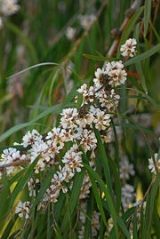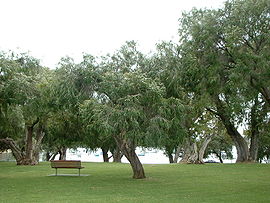
Agonis flexuosa
Encyclopedia
Agonis flexuosa is a species of tree
that grows in the south west
of Western Australia
. It is easily the most common of the Agonis
species, and is one of the most recognisable trees of Western Australia, being commonly grown in parks and on road verges in Perth
.
The species is commonly known as Western Australian Peppermint, Swan River Peppermint or Peppermint, and Willow Myrtle for its weeping habit.
s of small white flowers in the axes. It grows in a weeping habit, and looks remarkably like the weeping willow
from a distance. Leaves are narrow and reach a length of 150mm, It is most readily identified by the powerful odour of peppermint
that is emitted when the leaves are crushed or torn.
It flowers between August and December. The fruit is a hard capsule, 3 to 4 mm across, with three valves producing small seeds.
for "full of bends", referring to the zig-zag course of the stem, which changes direction at each leaf node. It was originally placed in the Leptospermum
genus by Sprengel in 1819, but Schauer placed it in Agonis in 1844.
There are two recognised varieties: Agonis flexuosa var. flexuosa and Agonis flexuosa var. latifolia. The cultivar Agonis flexuosa 'Nana is a dwarf form that is commonly seen in Perth as a hedge
.
, then along the coast to outlying records east of Bremer Bay
(34°23'S).
 The habitat includes limestone heath, stable dunes, and sandy soils; usually inland from the coastline, and as a under-story in Tuart forest.
The habitat includes limestone heath, stable dunes, and sandy soils; usually inland from the coastline, and as a under-story in Tuart forest.
Tree
A tree is a perennial woody plant. It is most often defined as a woody plant that has many secondary branches supported clear of the ground on a single main stem or trunk with clear apical dominance. A minimum height specification at maturity is cited by some authors, varying from 3 m to...
that grows in the south west
Southwest Australia
Southwest Australia is a biodiversity hotspot that includes the Mediterranean forests, woodlands, and scrub ecoregions of Western Australia. The region has a wet-winter, dry-summer Mediterranean climate, one of five such regions in the world...
of Western Australia
Western Australia
Western Australia is a state of Australia, occupying the entire western third of the Australian continent. It is bounded by the Indian Ocean to the north and west, the Great Australian Bight and Indian Ocean to the south, the Northern Territory to the north-east and South Australia to the south-east...
. It is easily the most common of the Agonis
Agonis
Agonis is a genus of four species in the plant family Myrtaceae. All are endemic to Western Australia, growing near the coast in the south west.Only one, Agonis flexuosa, grows to tree size, the others generally growing as tall shrubs....
species, and is one of the most recognisable trees of Western Australia, being commonly grown in parks and on road verges in Perth
Perth, Western Australia
Perth is the capital and largest city of the Australian state of Western Australia and the fourth most populous city in Australia. The Perth metropolitan area has an estimated population of almost 1,700,000....
.
The species is commonly known as Western Australian Peppermint, Swan River Peppermint or Peppermint, and Willow Myrtle for its weeping habit.
Description
A. flexuosa occurs mainly as a small and robust tree, usually less than 10 metres tall, although it may grow to 15 metres. It has fibrous brown bark, and long, narrow, dull green leaves, with tightly clustered inflorescenceInflorescence
An inflorescence is a group or cluster of flowers arranged on a stem that is composed of a main branch or a complicated arrangement of branches. Strictly, it is the part of the shoot of seed plants where flowers are formed and which is accordingly modified...
s of small white flowers in the axes. It grows in a weeping habit, and looks remarkably like the weeping willow
Willow
Willows, sallows, and osiers form the genus Salix, around 400 species of deciduous trees and shrubs, found primarily on moist soils in cold and temperate regions of the Northern Hemisphere...
from a distance. Leaves are narrow and reach a length of 150mm, It is most readily identified by the powerful odour of peppermint
Peppermint
Peppermint is a hybrid mint, a cross between the watermint and spearmint . The plant, indigenous to Europe, is now widespread in cultivation throughout all regions of the world...
that is emitted when the leaves are crushed or torn.
It flowers between August and December. The fruit is a hard capsule, 3 to 4 mm across, with three valves producing small seeds.
Taxonomy
The genus name Agonis comes from the Greek agon, "a cluster", referring to the arrangement of the fruits. The species name flexuosa is LatinLatin
Latin is an Italic language originally spoken in Latium and Ancient Rome. It, along with most European languages, is a descendant of the ancient Proto-Indo-European language. Although it is considered a dead language, a number of scholars and members of the Christian clergy speak it fluently, and...
for "full of bends", referring to the zig-zag course of the stem, which changes direction at each leaf node. It was originally placed in the Leptospermum
Leptospermum
Leptospermum is a genus of about 80-86 species of plants in the myrtle family Myrtaceae. Most species are endemic to Australia, with the greatest diversity in the south of the continent; but one species extends to New Zealand, another to Malaysia, and L. recurvum is endemic to Malaysia.They...
genus by Sprengel in 1819, but Schauer placed it in Agonis in 1844.
There are two recognised varieties: Agonis flexuosa var. flexuosa and Agonis flexuosa var. latifolia. The cultivar Agonis flexuosa 'Nana is a dwarf form that is commonly seen in Perth as a hedge
Hedge (gardening)
A hedge or hedgerow is a line of closely spaced shrubs and tree species, planted and trained in such a way as to form a barrier or to mark the boundary of an area. Hedges used to separate a road from adjoining fields or one field from another, and of sufficient age to incorporate larger trees, are...
.
Distribution and habitat
A. flexuosa occurs in a sub-coastal strip from just north of Perth, southward through the Swan Coastal PlainSwan Coastal Plain
The Swan Coastal Plain in Western Australia is the geographic feature which contains the Swan River as it travels west to the Indian Ocean. The coastal plain continues well beyond the boundaries of the Swan River and its tributaries, as a geological and biological zone, one of Western Australia's...
, then along the coast to outlying records east of Bremer Bay
Bremer Bay, Western Australia
Bremer Bay is a coastal town situated on the south coast of Western Australia in the Great Southern region between Albany and Esperance, at the mouth of the Bremer River. Bremer Bay is southeast of the state capital, Perth, and east of Albany. The town has a population of about 240...
(34°23'S).


